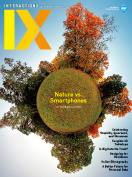Authors:
Rong-Hao Liang, Liwei Chan, Hung-Yu Tseng, Han-Chih Kuo, Da-Yuan Huang, De-Nian Yang, Bing-Yu Chen, Tobias Grosse-Puppendahl, Sebastian Beck, Daniel Wilbers, Arjan Kuijper, Heejeong Heo, Hyungkun Park, Seungki Kim, Jeeyong Chung, Geehyuk Lee, Woohun Lee, Carl Unander-Scharin, Åsa Unander-Scharin, Kristina Höök, Ludvig Elblaus
GaussBricks is a novel building-block system for tangible interaction design that enables real-time constructive tangible interactions on portable displays. The simple mechanical design of the magnetic building blocks facilitates the construction of configurable forms. The forms constructed from the magnetic building blocks, which are connected by magnetic joints, allow users to stably manipulate them with various elastic force-feedback mechanisms. With an analog Hall-sensor grid mounted to its back, a portable display determines the geometrical configuration and detects various user interactions in real time. This work also introduces several methods to enable actuated shape changing, multi-touch input, and display capabilities in the constructed form. The proposed building-block system enriches how individuals physically interact with portable displays.
http://graphics.csie.ntu.edu.tw/~howieliang/GaussBricks.html
http://www.cmlab.csie.ntu.edu.tw/~howieliang/HCIProjects/projectGauss.html
https://www.youtube.com/watch?v=mtjOwSZbpZQ
Liang, R-H, Chan, L., Tseng, H-Y, Kuo, H-C, Huang, D-Y, Yang, D-N, and Chen, B-Y. GaussBricks: Magnetic building blocks for constructive tangible interactions on portable displays. Proc. of CHI 2014. ACM, New York, 2014, 3153–3162.
Rong-Hao Liang, Liwei Chan, Hung-Yu Tseng, Han-Chih Kuo, Da-Yuan Huang, De-Nian Yang, Bing-Yu Chen, National Taiwan University and Academia Sinica
[email protected]
 |
Basic building block designs support stable, configurable, and transparent physical-form construction. |
Gesture-based interaction methods are now supported by a wide variety of devices, such as capacitive trackpads and capacitive 3D gesture-recognition systems. When interacting with such proximity-sensing surfaces, users face the challenge that the supported gestures are not directly apparent. Rainbowfish tackles this problem by combining a semi-transparent capacitive proximity-sensing surface with an LED array. The LEDs are used to visually indicate possible gestural movements and provide feedback on the current interaction status. Aside from computer-centered interaction, Rainbowfish can be used as a low-cost gesture-recognition system for home automation, for example as a gesture-controllable door opener.
Grosse-Puppendahl, T., Braun, A., Kamieth, F., and Kuijper, A. Swiss-cheese extended: An object recognition method for ubiquitous interfaces based on capacitive proximity sensing. Proc. CHI 2013. ACM, New York, 2013.
Grosse-Puppendahl, T., Beck, S., Wilbers, D., Zeiss, S., von Wilmsdorff, J., and Kuijper, A. Ambient gesture-recognizing surfaces with visual feedback. Proc. HCII'14. Springer, 2014.
Tobias Grosse-Puppendahl, Fraunhofer IGD
[email protected]
Sebastian Beck, Fraunhofer IGD
[email protected]
Daniel Wilbers, Fraunhofer IGD
[email protected]
Arjan Kuijper, Fraunhofer IGD and Technische Universität Darmstadt
[email protected]
 |
Rainbowfish shows users supported gestures depending on the current state. |
What would it be like to allow people to see each other through an interactive transparent display? We propose a concept called TransWall, which allows users to experience collocated face-to-face multimodal interactions through a transparent display. To implement this concept, we made a see-through display touchable on both sides and added more interaction possibilities, such as audio capabilities and vibrotactile feedback. TransWall enables people to see, hear, or even touch other people through the display while enjoying both the content and the interpersonal communication.
http://designmedia.kaist.ac.kr/
Heo, H., Park, H-K, Kim, S., Chung, J., Lee, G., and Lee, W. Transwall: A transparent double-sided touch display facilitating co-located face-to-face interactions. CHI 2014 Extended Abstracts. ACM, New York, 2014, 435–438.
Heo, H., Kim, S., Park, H., Chung, J., Lee, G., and Lee, W. TransWall. ACM SIGGRAPH 2013 Emerging Technologies. ACM, New York, 2013, Article 14.
Heejeong Heo, KAIST
[email protected]
Hyungkun Park, KAIST
[email protected]
Seungki Kim, KAIST
[email protected]
Jeeyong Chung, KAIST
[email protected]
Geehyuk Lee, KAIST
[email protected]
Woohun Lee, KAIST
[email protected]
 |
TransWall allows people to see, hear, and touch others through the display while interacting with display content. |
Opera singers can use the Vocal Chorder, a large interactive instrument, to add new elements to their performance. The device allows performers to interactively accompany themselves through pushing, leaning on, and bending steel wires. Audience members can also use the instrument to interact with the operatic voice. When a person steps into the Vocal Chorder, its wires enable full-body interaction to explore the sounds and the interactive pyramid projected in front of the performer. It is a visualization of the child in Ray Bradbury's short story "Tomorrow's Child," born in another dimension and perceivable by its parents only as a pyramid.
http://www.electronic-opera.com/thevocalchorder
http://www.youtube.com/watch?v=oxUGb6rmFos
Unander-Scharin, C., Unander-Scharin, A., Höök, K., and Elblaus, L. Interacting with the vocal chorder: Re-empowering the opera diva. CHI 2014 Extended Abstracts. ACM, New York, 2014, 603–606.
Unander-Scharin, C., Unander-Scharin, A., and Höök, K. The Vocal Chorder: Empowering opera singers with a large interactive instrument. Proc. CHI 2014. ACM, New York, 2014, 1001–1010.
Carl Unander-Scharin, University College of Opera and KTH Royal Institute of Technology
[email protected]
Åsa Unander-Scharin, Luleå University of Technology
[email protected]
Kristina Höök, Mobile Life@KTH Royal Institute of Technology
[email protected]
Ludvig Elblaus, KTH Royal Institute of Technology
[email protected]
 |
Performers accompany themselves by pushing, leaning on, and bending steel wires. |
©2014 ACM 1072-5220/14/09 $15.00
Permission to make digital or hard copies of all or part of this work for personal or classroom use is granted without fee provided that copies are not made or distributed for profit or commercial advantage and that copies bear this notice and the full citation on the first page. To copy otherwise, to republish, to post on servers or to redistribute to lists, requires prior specific permission and/or a fee.
The Digital Library is published by the Association for Computing Machinery. Copyright © 2014 ACM, Inc.








Post Comment
No Comments Found